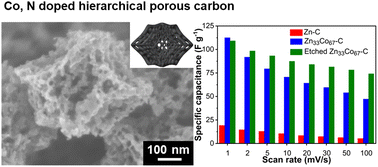Enlarging the porosity of metal–organic framework-derived carbons for supercapacitor applications by a template-free ethylene glycol etching method†
Abstract
In this work, hierarchically porous bimetallic zeolitic imidazolate framework (ZIF) particles (etched Zn33Co67-ZIF) exhibiting both micropores and mesopores have been designed and prepared through an ethylene glycol-assisted aqueous etching method. The etching process effectively increases the pore size, surface area, and pore volume of the bimetallic ZIF particles. After the thermal treatment, the etched Zn33Co67-ZIF particles are transformed into cobalt and nitrogen co-doped hierarchically porous carbon (i.e., etched Zn33Co67–C). Etched Zn33Co67–C has an increased mesoporosity, leading to an approximately 45% increase in its specific capacitance compared to the unetched one. In addition, etched Zn33Co67–C displays a higher capacitance retention (67%) than unetched Zn33Co67–C (41%) over a range of scan rates from 1 to 100 mV s−1. The presented ethylene glycol-assisted aqueous etching process provides a facile template-free strategy to enlarge the porosity of MOFs and their corresponding porous carbons for improving their energy storage performance.

- This article is part of the themed collections: Celebrating International Women’s day 2024: Women in Materials Science, 2024 Journal of Materials Chemistry A Lunar New Year collection and Celebrating ten years of Journal of Materials Chemistry A


 Please wait while we load your content...
Please wait while we load your content...